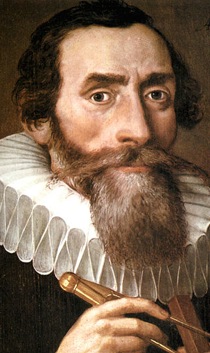
Continues from the Ptolemy Effect

was born in December 1571 in Weil, South Germany. Went to school then Lutherian Seminary when 13 years old. At 17 went to University of Tübingen. Graduated in arts aged 20, then studied theology. Lost interest in religion soon, and studied astronomy under Michael Maestlin, and maths. Job as teacher of maths and astronomy in Graz. In 1596 aged 25, wrote Mysterium Cosmographicum. Had idea that the universe was built around certain geometrical figures like pyramid and cube. Sent copies out to noted scientists including Tycho Brahe, who invited him to work for him. Moved to Prague with his family in 1600.
On Tycho's death took over his observatory and kept all Tycho's papers, despite the complaints of Tycho's heirs. When Rudolph II died in 1612, Kepler moved to Linz for 14 years. Died in Regensburg in 1630.
It was when he was working on the orbit of Mars for Brahe in Prague that Kepler realised the planet - and all the planets must rotate about the sun in ecliptical orbits. This was really revolutionary. Even Tycho Brahe did not venture to go the whole hog and admit that Copernicus was right to have the planets orbiting the sun. He would only acept that Mercury and Venus did - since observations had shown it could not be otherwise. Eclliptical orbits completely shattered the tomlemiac view of the universe - and led to new questions about gravity for example.
Kepler also worked on and designed better cameras and telescopes to use for observation. A mission aimed at detecting planets around other stars has been named after Kepler.
The name telescope was suggested in 1611, by the Greek mathematician John Demisiani at a banquet in Rome, where Galileo and his telescope were the guests of honour. Until then it was referred to as a "spy-glass".
The telescope was to completely change one of the purposes of astronomy - and scupper what was until then, the main source of income for the astronomer. The casting of horoscopes, which depended on the belief in a fixed limited universe with the Earth and its inhabitants in a central and most important position. This belief was banished from science forever when the telescope revealed there really were other worlds and infinite stars.
For thousands of years, astronomy had been used for calendars and for divination. Now divination was replaced by the exploration of the universe. The telescope showed that there was far more in the universe than anyone had ever seen before. That there really were strange other worlds, for so long only imagined. And the bigger and better the telescope, the more that was revealed.
The camera, part of the telescope, or the other way round, has a recorded history of use as an indispensable aid in astronomy going back far more than 2,000 years. When the Sun's rays are projected on to a smooth surface through a tiny hole in a dark room or box, the image of the Sun can been seen projected upside down on the surface. Hence the name from the Italian for dark room - camera obscura.
This idea may have been noticed and made use of for thousands of years, for there are ancient monuments like New Grange in Ireland which make use of a shaft of light from the Sun hitting a particular marked part of a wall at a definite time of the year - the Winter Solstice in this case.
Such a construction was known to have been used by astronomers or astronomer priests or shamans, to fix annual calendars, and to observe the Sun. Chinese astronomers were making records of sun spots, more than 2,000 years ago, as well as of eclipses. They had to draw or paint over the image projected, as it was not until the 19th century that satisfactory methods of preserving the image were developed. They could not have seen the sun spots without this form of projection of the Sun's image, as the Sun is far too bright. Otherwise they could only view the Sun though a thin cloud or mist.
The telescope also had its origins way back in a device used by astronomers for at least 2,000 years. This was the sighting tube. If you look through a tube with a matt black interior surface at a star it will look clearer. (Try it with the cardboard tube from the kitchen foil roll, or rolled up black paper, or the cardboard tube it was rolled up on). Astronomers used the sighting tube to assist them in aligning their other instruments on a particular star. Pictures from the middle ages show astronomers apparently looking through telescopes. These were sighting tubes and did not have lenses in them.
The sighting tube could be fixed to the armillary or other instrument it was used with. The clockwork driven armillary sphere made by Chinese astronomer Zhang Heng (78 - 142) is thought to have had a sighting tube attached, which would have made it the first recorded ancestor of the clockwork driven telescope, keeping itself aligned to the same part of the sky. These clockwork driven sighting tubes were usual in Chinese observatories of the 7th century on. The armillary on the great 10th century astronomical clock of Su Sung had a sighting tube.
By this time the qualities of different glass lenses were appreciated. In the 13th century reading glasses reached Europe from China, to help the long sighted. The first telescopes were sighting tubes with lenses. But they did not come into use until well into the 16th century. And it was not until the 16th century either that the short-sighted could be helped by glasses to see distance. And lenses were used in cameras. Microscopes were even later still. The reason was the quality of the lenses. Early glass was full of bubbles and uneven.
Telescopes needed more than one lens to work, and this magnified the faults. Without a clear enough image, a small fuzzy blob became a larger fuzzy blob. It all depended on improvements in glass making technology.
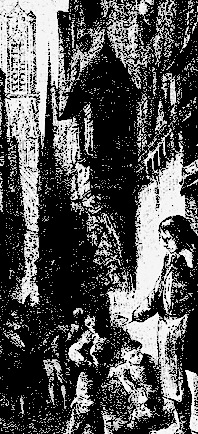
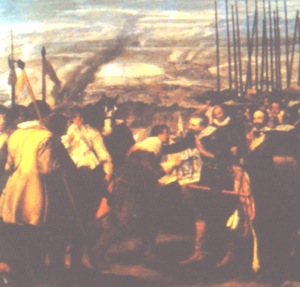 The first known patent for a workable telescope was applied for by Hans Lippershey - a spectacle maker of Middelburg in Zeeland in September 1608. The telescope was invented by his children. He used to let them play with unwanted lenses. The children discovered that if they looked at the church tower through two lenses held a short distance from each other, it appeared close up. They showed their father and he made up the first "spy-glass". And instantly patented it, realising there was an immense market for such a device especially for use at sea.
The first known patent for a workable telescope was applied for by Hans Lippershey - a spectacle maker of Middelburg in Zeeland in September 1608. The telescope was invented by his children. He used to let them play with unwanted lenses. The children discovered that if they looked at the church tower through two lenses held a short distance from each other, it appeared close up. They showed their father and he made up the first "spy-glass". And instantly patented it, realising there was an immense market for such a device especially for use at sea.
Lippershey presented his spy-glass to Count Maurice of Nassau, who immediately ordered three more and ordered him to keep his methods secret. He saw is as a useful spying weapon in war and the picture shows the telescope being used in war.
But no sooner had the spy-glass been patented and advertised, others were circumventing Lippershey's patent with devices of their own.
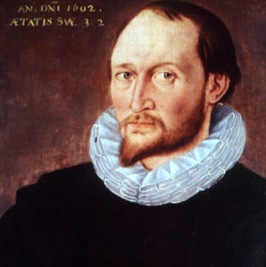
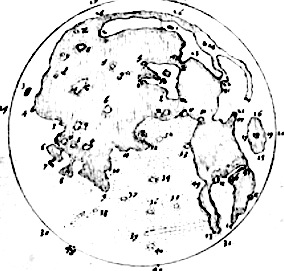
Galileo (1564-1642) had a workshop making scientific instruments in Padua at the time. He did not find out about the Dutch spyglass until he was in Venice in 1609 a year after its invention. He realised its potential at sea, and for observing which ships were coming into the harbour. He knew that he could make a fortune by selling such a device to the shipping magnates of Venice. The invention was already being sold in Paris, in Milan, and a salesman from the Netherlands had turned up in Padua with the new spyglasses to sell.
Galileo dashed back home but the Dutch salesman had left. So he missed getting an instrument to copy. He had to invent his own. Urgently. With his toolmaker Marc'antonio Mazzoleni, and a glass maker to make an assortment of lenses, Galileo worked all through the night and the next day. They kept trying different combinations of different concave and convex lenses along a lead tube, until by the end of the day, they had a working instrument. Immediately Galileo sent a message to a friend in Venice to try to prevent any foreign salesmen with new spyglasses, gaining access to the Venetian authorities. That was 4th August 1609.
By the 20th August, Galileo had a x10 power spyglass ready to take to Venice. He still managed to consider design and packaging, his new instrument was handsomely finished. And he knew the importance of a good presentation. His friends in Venice had already been primed and arranged an impressive ceremony to display Galileo's device to the Doge, his counsellor, the Chiefs of the Council of Ten, and the Sages of the Order, who commanded the Venetian navy. To be followed by a huge public demonstration, showing the use of the spyglass to recognise distant ships coming into the harbour. This included a ceremony when Galileo presented his spyglass to the Doge as a gift.
He rushed home with orders and also had to work on the improvements necessary if he was to stay ahead of his rivals. He obtained new lenses from the best lens makers in Florence and gave them a final polish himself. Soon he was able to increase his instruments' power and effectiveness to x 20 power.
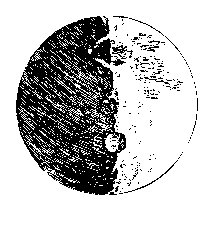 Galileo decided to look at the moon with one of his x 10 power telescopes. He thought he could see mountains and seas (still called mare from the Latin, although later realised to be lava plains). Galileo made drawings of his observations and calculated the heights of the mountains. He noted that a large circular crater seemed to resemble the basin of Bohemia on Earth. (He was right, it is a giant impact crater).
Galileo decided to look at the moon with one of his x 10 power telescopes. He thought he could see mountains and seas (still called mare from the Latin, although later realised to be lava plains). Galileo made drawings of his observations and calculated the heights of the mountains. He noted that a large circular crater seemed to resemble the basin of Bohemia on Earth. (He was right, it is a giant impact crater).
Not all Galileo's instruments were as good as that one, some were useless, but the good ones, when directed to the night sky, were making startling new discoveries. Many hitherto unseen stars were revealed for the first time.
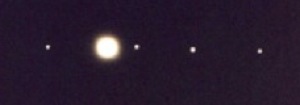 Then in January 1610, Galileo made a really significant discovery. He saw three then tracked four moons orbiting Jupiter.
Then in January 1610, Galileo made a really significant discovery. He saw three then tracked four moons orbiting Jupiter.
He rushed to publish this in a book "Siderius Nuncius" (Starry Messenger) in March. In this book, he described his new spyglass, the appearances of planets which showed discs, and stars which didn't - thus showing that they must be very much farther away - and the new moons of Jupiter.
The discovery of the moons orbiting Jupiter was a further nail in the coffin of the old Earth centred view of the universe, and it conflicted with the established view of the Catholic Church, and with the authority it wished to wield over everyone on the planet, which was already severely challenged.
With regard to publicity and marketing, and possible research funding, Galileo dedicated his book on his new discoveries, to the ruler of Tuscany Cosimo Medici, and suggested he named the moons of Jupiter after him and his family. The reply was to name them the Medicean moons. The rest of the world was not behoven to the patronage of the Medici, and they are still called the Galileian moons.
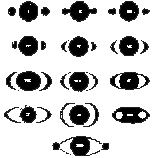 In July, Galileo turned his spyglass on Saturn and it looked rather strange. He sent a coded message to Johannes Kepler and other prominent astronomers which baffled them. Kepler finally persuaded Galileo to explain it, as the Emperor Rudolph II wanted to know what it was all about. Did Saturn have handles. Other astronomers saw different things.
In July, Galileo turned his spyglass on Saturn and it looked rather strange. He sent a coded message to Johannes Kepler and other prominent astronomers which baffled them. Kepler finally persuaded Galileo to explain it, as the Emperor Rudolph II wanted to know what it was all about. Did Saturn have handles. Other astronomers saw different things.
In 1656, Dutch scientist Christiaan Huygens (1629-1695) collected all the observations made of Saturn as seen in picture on the right, and realized that it was a planet with rings around it.
In Galileo's telescopes the eye looks first through a concave lens, and then through a convex lens, and the image is the right way up. Johannes Kepler (1571 - 1630) was short-sighted, and got very frustrated when he was unable to see anything through his telescope but fuzzy blobs.
While employed by the Emperor Rudolph II as Tycho Brahe's successor in Bohemia, he produced and published some work which some later scientists prefer to forget - but which was just as important in his time, as the work they consider seminal in modern science, especially on orbits - his discovery that they are elliptical, and on optics. His work on optics was finished in 1611, which was a horrible year for him, as his wife died, one of his children died, his mother was accused of being a witch, imprisoned and tortured, and his employer was deposed, so he was left without a salaried job.
The type of telescope he had designed became the one which astronomers preferred and which is still used by amateurs. In the Keplerian telescope, the eye looks first through a convex lens - this is part of the eyepiece - and then through another convex lens - this is the objective. The image is seen upside down, but there is a wider field of view.
Kepler also worked on the development of the camera with a lens. By the 17th century, all the uses we would have for a camera were there, except there was still no way of retaining the image produced ecept by projecting it and drawing or painting over the projected image. There were portable cameras for artists and map makers. There were spy cameras - hidden in a wine glass at a banquet for example. There was cinema - the audience sat in a dark room. Outside in the sunshine, actors performed a play or entertainers a show and this was projected onto a screen in front of the audience.
And with the telescope as the lens you had an astronomical instrument used for viewing the Sun without damaging your eyes seriously. As astronomers found out the hard way - you should never look through a telescope directly at the sun, even for the briefest moment. Those black spots (caused by retina burn) that result in the vision can last for days, and can be permanent.
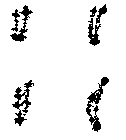 Galileo discovered sun spots. He was not the only one.
Galileo discovered sun spots. He was not the only one.
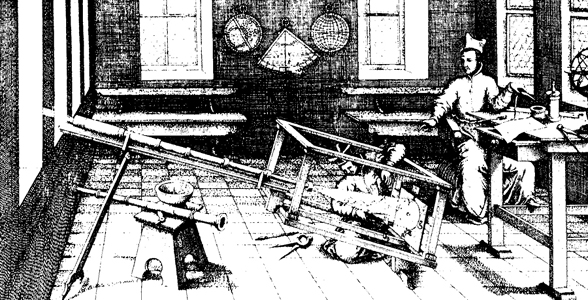
Christopher Scheiner (1573-1650), made careful observations and measurements of sun spots, using his telescope set up as part of a camera obscura - as in the picture. But spots on the Sun, conflicted with established belief that the heavenly orbs should be perfectly unblemished.
Scheiner had been educated at Jesuit Colleges. In 1610 he was Professor of Mathematics and Hebrew at Ingolstadt University, and had made his own telescope the following year. 1616 he was invited to the court in Innsbruck and ordained priest. 1633 he lived in Vienna and from 1639 in Nysa in Poland.
As a Jesuit Priest, Scheiner was forbidden to publish his discoveries. He got around this censorship, by sending his work to a friend, Marc Wesler, in Augsburg, who had his letters published under a false name, and made sure that Kepler and Galileo had copies. Scheiner attempted to find another cause for the spots. In his observations he observed that Mercury and Venus definitely orbited the Sun. This again conflicted with the established religious views he was expected to uphold.
Although Galileo liked to claim credit for all the new astronomical discoveries, - and sell more of his own telescopes - many other astronomers now were using telescopes of their own and making their own discoveries and observations of the Moon's surface, the Sun's spots, Jupiter's moons etc. Galileo, accused Scheiner of plagiarising his work - which was not true.
This was to make a potential ally into a dangerous enemy, when he was persecuted by the Inquisition. By recanting, he avoided the awful fate of Giordano Bruno, arrested for promoting the Copernican system, with the Earth in orbit with the other planets around the Sun and promoting the idea that our solar system could be one of many around infinite numbers of stars. Bruno was lured to Rome, where he was arrested, imprisoned and tortured for 8 years, then in 1600, he was dragged in chains with a spike driven through his mouth and jaw, and burnt alive.
It was not until November 1982, that the Vatican finally came to the official decision that Galileo (and others) had been right when they claimed the Earth moved around the Sun.
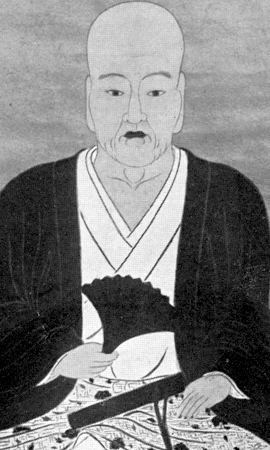 On the 21st June 1613, the "Clove" was boarded by the Daimyo of Hirado, Matsura Hoin - (he had actually retired in favour of his grandson and taken monk's vows, but still acted as Regent for his grandson).
On the 21st June 1613, the "Clove" was boarded by the Daimyo of Hirado, Matsura Hoin - (he had actually retired in favour of his grandson and taken monk's vows, but still acted as Regent for his grandson).
They came on board twice, and brought presents and women entertainers on board to enliven the party. Saris gave them musical entertainment in return, and buffets of various bottled preserves they had stored for the voyage from England. Saris presented to the Daimyo as gifts: "a prospective glass and a wrought nightcap of black silk and gold". The prospective glass is what a telescope was first called so Matsura Hoin was (as far as is known) the first owner of one in Japan. In return Hoin gave the English travellers a house to stay in while they waited for a message to be received and returned from William Adams in Edo (now Tokyo). When Adams arrived, Saris and his officers with their translator were taken to see the former Shogun Ieyasu, the current Shogun Hidladu and the rest of the court, to present King James I's letter and gifts.
On November 26, Saris set up the English factory at Hirado. He offered William Adams a passage to England to return to his wife and family there, but the Shogun would not allow Adams to leave, and Adams anyway, did not get on with Saris. At least he was able to send a letter and other things for his wife and children in England and was able to continue to communicate with them. By now though, Adams also had a Japanese wife and family. The "Clove" left for England on December 5th. The English as well as the Dutch continued to expand exploration and trade in the Far East and Adams was part of this. He died in 1620.
In 1627, the Rudolphine Tables were published. These were based on the observations made by Tycho Brahe and Johannes Kepler, and were the most accurate that had ever been published. They were followed by updates. They made it possible for astronomers to plan new observations never before possible.
In 1639, Jeremiah Horrocks (1618-41), and William Crabtree (1610-44) who were penfriends, were the first to use telescopes to observe the transit of Venus, which they found predicted in the astronomical tables of Philip von Lansberg (1561-1632). A transit is when a planet between us and the Sun, Mercury or Venus comes into the line of sight between Earth and the Sun, and can be observed as a black spot crossing the Sun's surface.
Horrocks, had recently graduated from university and was working as a private tutor. He set up his camera obscura type device in an upstairs bedroom of the house he worked in. The eyepiece of the camera was shrouded by the curtained window, and the image was to project on marked out white card, which he had prepared and set up ready. But the day was cloudy and Horrocks was busy looking after the children. Luckily the sky cleared just in time. And Horrocks was able to see and record the transit. Crabtree was also able to observe the transit. In 1641, Horrocks died, aged 23, the day before he was to have visited Crabtree for the first time. Crabtree died in the Civil War.
Another friend of Horrocks, William Gascoigne was also killed in the Civil War, at the Battle of Marston Moor on 2nd July, 1644. He had invented the micrometer, which is a device used with a telescope for measuring small angular distances. The micrometer enabled direct measurements through a telescope to be made of planets and the positions of the heavenly objects. It made the telescope extremely useful for mapping the skies and determining the positions of the stars with an accuracy never before achieved. Unfortunately, Gascoigne was never credited with his invention until much later. Others developed their own version.
Another invention which with the telescope was to revolutionize astronomy, was the pendulum. A means of precise timing is essential. New work on the pendulum and the mathematics of its movement in the 17th century, had many applications. An assistant would call out the beats of the pendulum. The next development was to use the pendulum to regulate a clock movement. Hevelius was one of the astronomers who tried this, but his clock was fixed onto the pendulum.
The invention of the pendulum clock where the pendulum regulates the movement is credited to Christaan Huygens, who was one of the founder members of the Académie des Sciences, who was granted a large pension and an apartment in its building. But he had to return home to Holland permanently after the Revocation of the Treaty of Nantes in 1688. Observatories used regulators based on the pendulum until the 1960s when atomic clocks replaced them.
A pendulum was useless at sea, though. Astronomers on scientific voyages had to assemble their clocks in an observatory on shore. Pendulums had a number a scientific applications on their own and were used for timing in astronomy too, even before the pendulum clock was developed. The Abbé de Choisy was called upon by the astronomers to call out the moves of the pendulum for timing when they stopped off at the Cape on the voyage to Siam. It was Hevelius who first tried to design and make a pendulum clock.
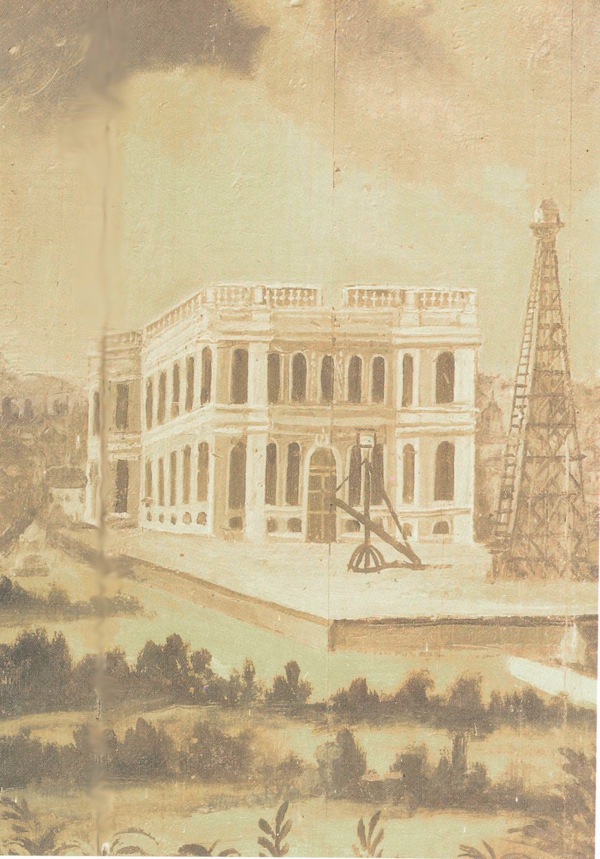
Jean Picard (1620-1682) working in Paris, introduced the concept of using telescopic sights (with micrometer) as an essential part of all observing equipment. It was Picard who suggested to King Louis XIV that Italian astronomer Giovanni Domenico Cassini (1625-1712), who was Professor of Astronomy at the University of Bologna) be invited to Paris as Director of the new Paris Observatory, which was completed in 1671.
Picard's main concern was the practical one of measuring the Earth, and the length of a meridian - which was essential for accurate mapping and navigation.
To determine the meridian of the new Paris Observatory, Picard travelled to Denmark, Tycho Brahe's old Observatory (see Great Medieval Mongol Observatories) on the island of Hveen. Determining its exact position and meridian would give a reference for the Paris Observatory. This brough him into contact with Danish astronomer Olé Römer, whome he invited to Paris. Römer was born at Århus, and educated in Copenhagen where he married the daughter of his professor Erasmus Bartholin.
Römer was invited to work at the Paris Observatory. One of the main methods to determine the Paris meridian of longitude was by the observation of the eclipses of Jupiter's satellites, as suggested by Galileo, who was awarded a gold chain as a prize. As a method for finding longitude at sea it turned out to be useless (see John Harrison and the Problem of Longitude for a full description of the methods used), but it was very useful on dry land.
When they started mapping France using the new data, it turned out to be much smaller than on earlier maps - causing King Louis XIV to complain that his astronomers had lost him more territory than his generals.
Römer's study of the movements of the moons of Jupiter led to his discovery of the speed of light. He noticed that when Jupiter was nearest the Earth on its orbit, the interval between the eclipses of the moons was less, than when Jupiter was further from the Earth on its orbit. In September 1679 he predicted than the eclipse of Io on 9th November would occur 20 minutes later than calculated. His explanation of the result, was than light was not instantaeous - according to established belief - but travelled at a certain speed. From this his estimated the speed of light - only slightly less than the modern mean value.
Römer designed many intruments to aid observation - one of this was a transit circle with telescopic sights. He returned to Denmark in 1681, where he was Astronomer Royal to King Christian V.
When Jesuit astronomers from Europe, were first appointed at the observatory in Beijing at the beginning of the 17th century, they had only one advantage over Chinese astronomers and that was more precise mechanical clocks.
In 1618, a Jesuit astronomer Johann Schreck, brought the first telescope to China. He had been in contact with Galileo, and (more helpfully) with Kepler. The telescope in Chinese was Yuan Ching (Far-Seeing Optick Glass).
The Jesuits had been of great scientific and technological assistance to the Manchu Dynasty when it conquered China, and their mathematicians achieved high office. This did not please everyone.
In 1664, the Jesuit Director of Beijing Observatory and Head of the Mathematical Board, Adam Schall (born 1592 Cologne) was challenged by the Chinese Muslim astronomer Yang Guangxian (1597-1669) who had published a pamphlet against the Jesuits.
The religion of the Manchu rulers of China was shamanistic. Their shamans were powerful and famous, and they had a tradition of public competitions between rival shamans demonstrating their magic powers. In the public astronomy competition, Yang won, Schall lost, and was thrown into prison.
One of the younger Jesuit astronomers who remained in China after the failure of Adam Schall, was Ferdinand Verbiest.
A famous Belgian, born in the Flemish speaking, mainly Catholic, linen growing and producing, region near Kortrijk (in French, Courtrai) on 9th October 1623.
Courtrai was occupied by the French in 1647. In 1656 Verbiest was to go on a boat from Lisbon to China with 36 other missionaries, the Viceroy of the Indies and other passengers.
Only 10 of the original passengers eventually reached Macao in 1659 (the Viceroy and most of the missionaries perished on the journey).
Verbiest started work in Shensi province. In 1660, Adam Schall, invited Verbiest to Beijing. The young Emperor Shun Chih himself arranged for Verbiest's journey to the capital.
The following year, in 1661 Shun Chih died aged only 23. The new Emperor, Kangxi had been born in May 1654. Although he was already given his first consort for his harem, he was still only a child and the government of the country was under four regents. They did not favour the Jesuits. One Jesuit missionary was accused of bribery and tortured.
After the failure of the astronomical competition, not only Adam Schall, but Verbiest and another Jesuit were arrested. Fortunately for them, on 16th April 1665, there was a violent earthquake and all the prisoners were released. They still had to stand trial, and all the Jesuits, but Verbiest, Schall, and two others were exiled to Canton. Schall then died, leaving Verbiest as the leading astronomer.
Meanwhile, the Emperor Kangxi was growing up, he married his first Empress, two years later, another consort gave him the first of 56 children.
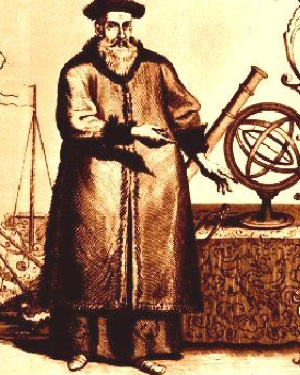
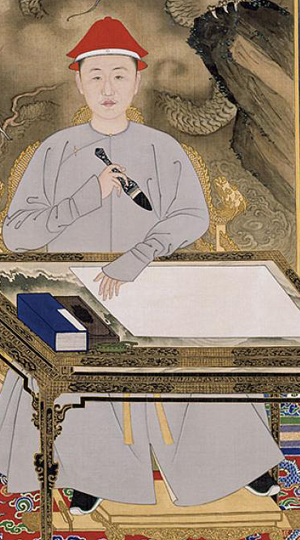 In 1669, serious errors were discovered in the calendar for 1670, which had been prepared by Yang Guangxian. This was brought to the attention of Emperor Kangxi, who decided to consult Ferdinand Verbiest. Verbiest commented that not only was the calendar full of errors but an extra month had been added unnecessarily, to bring the lunar months in line with the solar year.
In 1669, serious errors were discovered in the calendar for 1670, which had been prepared by Yang Guangxian. This was brought to the attention of Emperor Kangxi, who decided to consult Ferdinand Verbiest. Verbiest commented that not only was the calendar full of errors but an extra month had been added unnecessarily, to bring the lunar months in line with the solar year.
A meeting was called at court with Yang and everyone else involved, and Verbiest was challenged by Yang to prove his allegations. He offered that if they were to set up a gnomen in a palace yard, he could calculate the length of its shadow at any given hour; and from the length of the shadow, the height of the Sun; and from the height of the Sun, its place in the Zodiac. It would then be easy to check any statement in the calendar.
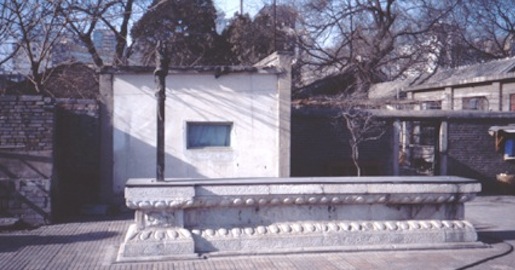 The lives of the combatants as well as their jobs and reputations were at stake. And for Verbiest, also the future of the Jesuit mission in China, and the reputation of European science.
The lives of the combatants as well as their jobs and reputations were at stake. And for Verbiest, also the future of the Jesuit mission in China, and the reputation of European science.
The gnomen was moved into position near the Wu-Men gate, just before noon. (You can see the gnomen or one like it at the old Beijing observatory shown in the picture). Watched by the Emperor and his court, the shadow on the gnomen scale shortened towards the line drawn by Verbiest.
 Verbiest had got it right. To be sure, the Emperor Kangxi insisted on more trials. Verbiest won each time. Unlike Yang, he had access to the latest updates on the Rudolphine tables made even more precise with the aid of telescopes for observation. Yang had the horrible death he had planned for his Jesuit rival.
Verbiest had got it right. To be sure, the Emperor Kangxi insisted on more trials. Verbiest won each time. Unlike Yang, he had access to the latest updates on the Rudolphine tables made even more precise with the aid of telescopes for observation. Yang had the horrible death he had planned for his Jesuit rival.
Verbiest took over his job as Head of the Mathematical Board and Director of the Observatory, which was constructed by part of the old city wall, with one of the towers as the viewing platform. This was completely renovated and equipped with new instruments.
A plaque on the tower commemorates this event. The observatory became derelict later, and was not restored until the early 1980s, when it was opened to the public. Since then, unfortunately, it has ceased to receive further government funding, and is now in a sad condition, with staff forced to sell some of the antique and reproduction instruments, that are not only on the viewing platform but in gardens around the compound. It is in a tiny part of traditional old Beijing, with decrepit traditional houses, old men playing board games, and old ladies hobbling past on bound feet. It is now hemmed in by mighty modern towers with advertising for electronic corporations, shrouded in dense polluted smog. See it before it goes. The viewing platform is easily visible through the smog.
In 1685, Verbiest was getting old (he died in 1688) and Jesuits in Europe were anxious that he should have a suitable successor.
Meanwhile King Narai of Siam (now Thailand) having heard from traders and missionaries about the new observatory in China and the splendours of the French King's new palace in Versailles with its mirrored halls, wanted to arrange contact and trade.
In December 1680, King Narai saw off the ship the "Soleil d'Orient" - containing his three ambassadors, and laden with valuable and impressive gifts for the French King Louis XIV.
Two years later, having had no news, the anxious King dispatched two envoys, with a French missionary, Bénigne Vachet to France via England, as they travelled on a British ship, to find out what had happened to his embassy, and equipped them with a shopping list which included mirrors like those at Versailles and an observatory like the one in Paris. (It was discovered later, that the ship had perished in a storm).
When they arrived in England, the French ambassador arranged for them to visit Charles II's French mistress, Louise de Keroualle. They were joined by Charles II, who gave orders to Samuel Pepys to take the Siamese ambassadors to Calais on the royal yacht, the Charlotte.
Once in France, Vachet was at a loss how to introduce the (now very cold in the winter climate) ambassadors to Louis XIV. Then Vachet met François-Timoléon, the Abbé de Choisy, who knew all the right people. The envoys from Thailand met King Louis XIV, his brother, and others of importance. This was an excellent opportunity for the French to send a scientific expedition to Siam (Thailand). From there, astronomers could go on to China to staff the observatory at Beijing.
Six Jesuit astronomers were appointed to go to Siam and then on to Beijing. They were:
Not all the scientists were Jesuits and missionaries, there were engineers and craftsmen equipped to build the observatory and also drains and fountains for King Narai. The astronomers were equipped with the latest tables from the Paris observatory of the satellites of Jupiter.
As well as the pendulums mentioned above, the expedition was equipped with - 12, 15, 18, 25, 50 and 80 foot telescopes, some were intended to be taken on to equip the Beijing Observatory.
Other instruments that were made specially for the expedition included:
Among the gifts to King Narai was a device for observing eclipses that he had requested. Vachet commented on its design. "As to the machine which is demanded to observe eclipses, it will be assumed that they only want to see the sun at the longitude and latitude of Siam, as then fewer adjustments have to be made. This machine is not universal; it is necessary to construct it following the elevation of Siam, and it is most important that it is easy to understand."
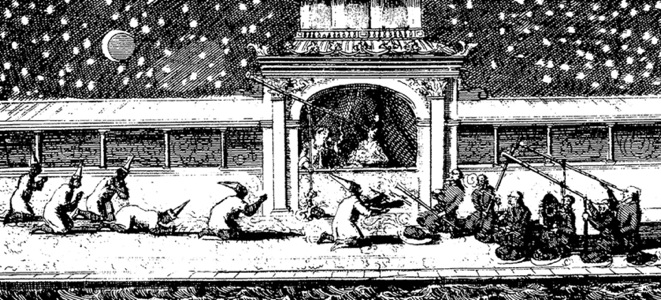 The expedition - the first French embassy to Siam, was loaded onto two ships and arrived towards the end of 1685. The astronomers had arranged to give a demonstration for King Narai at the lunar eclipse in the early hours of 11th December 1685.
The expedition - the first French embassy to Siam, was loaded onto two ships and arrived towards the end of 1685. The astronomers had arranged to give a demonstration for King Narai at the lunar eclipse in the early hours of 11th December 1685.
They used the waterside terrace of Narai's palace in Lopburi (the remains of which with impressive fortified walls, can still be seen), to set up their observational equipment. King Narai, had to be higher up than everyone else, and appeared at window, with a telescope set up for him.
Below him, on the terrace by the canal, the astronomers sat cross-legged on Persian carpets. Some at the telescopes, others at the pendulum for timing, and others were making notes.
The astronomers were taking advantage of the eclipse to find the longitude, and thus make their maps more accurate for future French expeditions to Siam. Longitude could be calculated by comparing the times of the beginning or ending of an eclipse of the Moon, and then comparing this data with the times recorded by observations made on the same eclipse at different places on the Earth. One disadvantage of this method was that eclipses of the Moon can only be seen once or twice a year, although the date and time of eclipses could be predicted fairly accurately by the 17th century. Another problem was that the Moon had to be adequately mapped, so the position of the shadow could be measured accurately.
This method of finding longitude only became possible after the invention of the telescope, when it was possible to make maps of the Moon so the exact position of the Moon's shadow at a given time could be observed in two or more positions on the Earth - in this case the eclipse was also being observed in Paris There were obvious difficulties when it was tried using small telescopes on the deck of a boat at sea as we have seen.
This was explained to King Narai. Tachard reported:
"The King expressed a particular satisfaction seeing all the Spots of the Moon in the Telescope, and especially perceiving that the Type or Map that was made at the Observatory of Paris agreed so well with it. He put several Questions to us during the eclipse; as for instance, Why did the Moon appear revers'd in the Telescope? Why was part of the Moon eclipsed, still to be seen? What o'clock was it at Paris? For what could Observations made by concert in remote Countries be useful etc."
The astronomers were presented with silver bowls containing gifts of silk clothes. (You can see them in the picture). King Narai wanted to look through the larger 12 foot telescope, which Fontenay was using. It had to be carried to the King. This caused a breakdown in traditional protocol. They had to set it up for the King first, which meant the King had to allow them to stand in his presence and allow them to look through the telescope first in order to set it up, before he got a chance to look through the eyepiece.
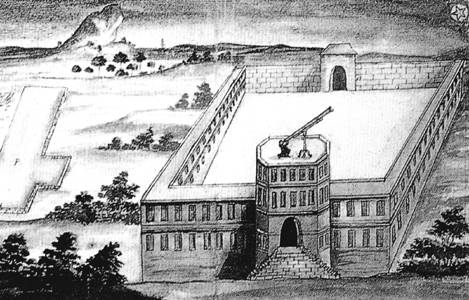
| The French were to return with more ships, and troops, and Jesuits, and an observatory was built in Lopburi. They depended on the help of a British man, Constantine Phaulkon, born on the island of Cephalonia, who had joined the British East India Company when 12 and worked his way up. The British East India Company and the Dutch VOC both had bases in Siam, the Portuguese and Japanese were there earlier. By the time the French arrived, Phaulkon was in charge of the King's Treasury and had a Japanese wife. |
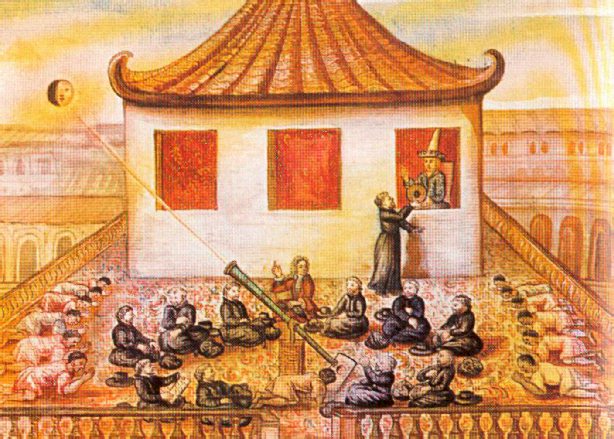 | On 30th April 1688, King Narai observed a partial eclipse of the sun in his newly built observatory at Lopburi, unaware that the eclipse was to be a signal for the start of a rebellion. |
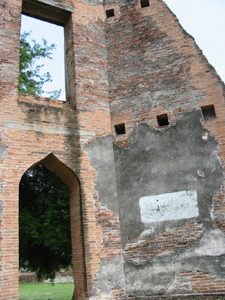 | King Narai was overthrown and died, Phaulkon was executed. And the French, who may have been part of the cause of the unrest, since they had built a military fort at Bangkok, and had been pushing their religion, were forced to leave the country. The ruins of the observatory in Lopburi which was also planned to be part of the Jesuit college with a church, can be seen today. (Links to further information here.). |
More information on historic eclipses.
Telescopes in 1670 enabled more accurate observations then previously, but were far from being precision instruments. There were a number of problems with this sort of telescope called a refractor. When light passes through the glass lenses, the image becomes distorted with coloured halos, especially near the edges. This is called aberration.
 To minimise this effect, refractors were made with very long focal lengths, and had to be suspended from a sort of crane. Flamstead in the Greenwich Observatory used a telescope 90 feet long. Cassini in the Paris Observatory used telescopes with focal lengths up to 136 feet long to observe Saturn. Since such a long rigid tube was difficult to use, it was often left out.
To minimise this effect, refractors were made with very long focal lengths, and had to be suspended from a sort of crane. Flamstead in the Greenwich Observatory used a telescope 90 feet long. Cassini in the Paris Observatory used telescopes with focal lengths up to 136 feet long to observe Saturn. Since such a long rigid tube was difficult to use, it was often left out.
The picture shows a telescope made in England by Christopher Cock being installed for Johannes Hevelius (1611 - 1687) in Danzig (Gdansk) Poland in 1670. In this telescope there is no tube, the objective and eyepiece are aligned through the square frames. The telescope has no automatic drive mechanism of any kind, so some observations could only be made for a minute or two before the telescope had to be readjusted manually into a new position.
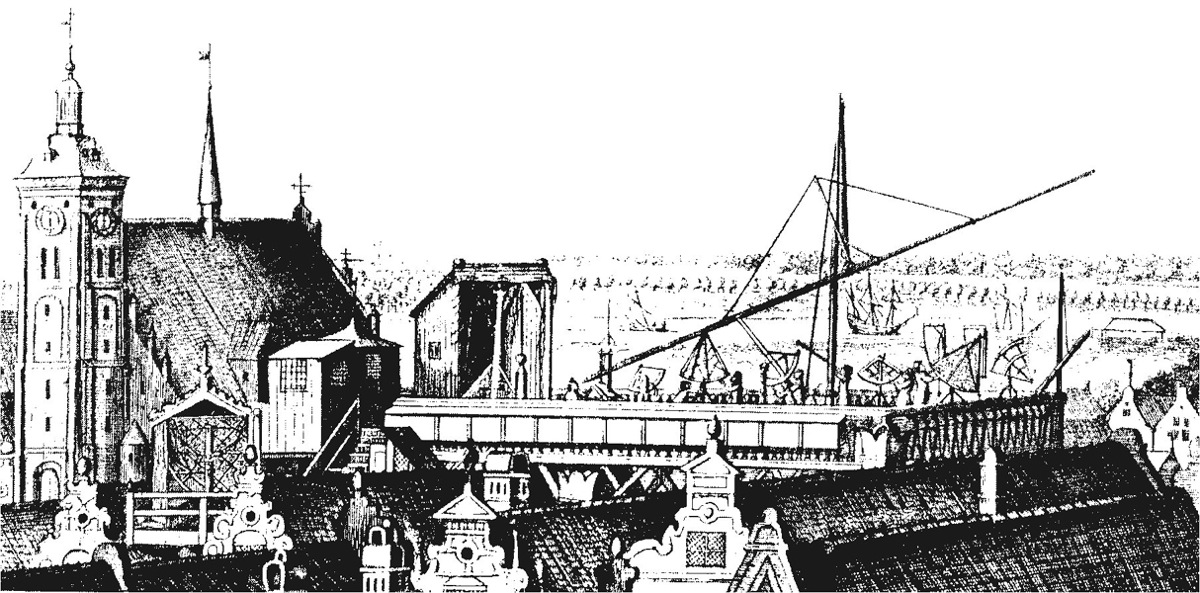
The next picture shows the observatory of Johannes in Gdansk, Poland. It extended over a number of rooftops.
Hevelius was a wealthy brewer which had enabled him to build the observatory in 1641, and spend his free evenings observing the moon, stars and comets. He then had the results of his observations published.
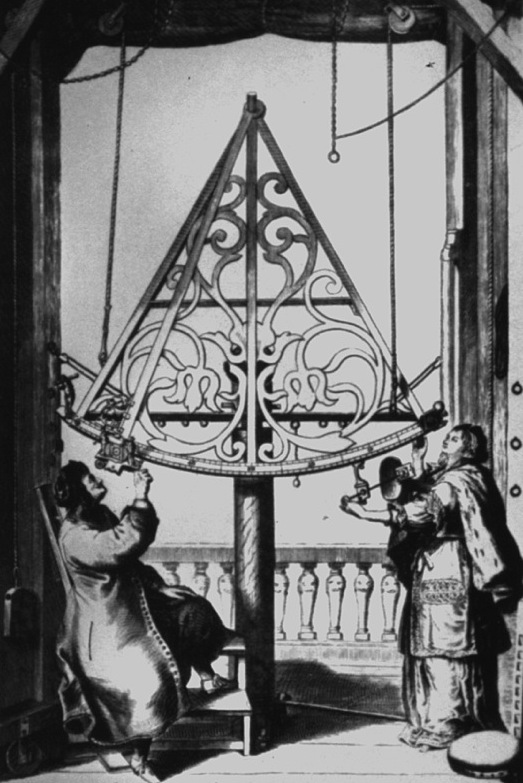 Robert Hooke (1635-1703) tried to persuade the elderly Polish astronomer Hevelius to use telescopic sights in his instruments. Otherwise, as Hooke was able to demonstrate to the Royal Society, his work on his star atlas, began in 1657, would be far too inaccurate for modern use. The picture shows Hevelius and his young second wife Elisabeth working together.
Robert Hooke (1635-1703) tried to persuade the elderly Polish astronomer Hevelius to use telescopic sights in his instruments. Otherwise, as Hooke was able to demonstrate to the Royal Society, his work on his star atlas, began in 1657, would be far too inaccurate for modern use. The picture shows Hevelius and his young second wife Elisabeth working together.
Edmund Halley, then 23, was sent out to Gdansk to persuade Hevelius. Elisabeth, Hevelius's second wife was forty years younger than her husband and he had trained her as an astronomer. Hevelius left the young astronomers to work overnight in the observatory while he went to bed.
Later, back in England, Halley got news that the Hevelius observatory had been destroyed in a fire and Hevelius had died. Halley sent Elisabeth as well as condolences, an expensive silk dress as a gift to wear when she came out of mourning. But Hevelius had survived to rebuild his observatory, and Halley married another girl.
Elizabeth continued to work on the the star atlas, called Uranographia, and published it after her husband's death in 1687.
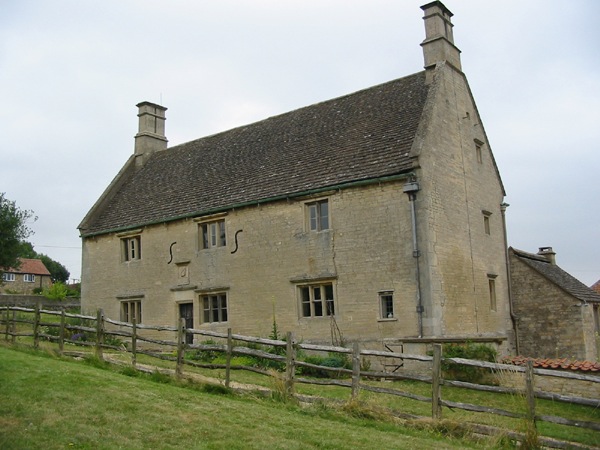 1642 Isaac Newton was born at Woolsthorpe prematurely on Christmas Day. He was named Isaac after his father who had just died. He was so small "he could fit into a quart pot" and they thought he wouldn't live, but he did - until aged 84.
1642 Isaac Newton was born at Woolsthorpe prematurely on Christmas Day. He was named Isaac after his father who had just died. He was so small "he could fit into a quart pot" and they thought he wouldn't live, but he did - until aged 84.
His mother Hannah, remarried and had more children. Isaac stayed at Woolsthorpe with his grandparents. It was a sheep farm. Until recently, it still was a farm. When her husband died, his mother returned to Woolsthorpe with her other children and the family was united.
Isaac was sent to Grantham Grammar school. Although Grantham is only a few miles away from Woolsthorpe, at that time it was too far to travel each day, so in term-time Isaac stayed with Mr. Clark the apothecary and his family, next to the George Inn. Newton like making things like sundials and windmills. His notebook survives.
Newton was expected to run the farm he had inherited, but he was so useless at it that his mother agreed to let him continue his education. In 1661 he went to Trinity College Cambridge. His mother could not pay the fees, so Newton had to work as a servant to the rich students to pay his way. He studied under the Lucasian Professor of Mathematics, Isaac Barrow (1630-77).
1665, Cambridge shut because of the plague. Newton returned home to Woolsthorpe. It was here at this time that he saw the apple fall from the tree in the orchard outside his bedroom. The orginal famous apple tree fell over and another apple tree, which you can see today sprouted from this so that apple tree is the orginal one still.
In 1664 there had been two very bright comets. Comets were thought to foretell disaster and here was the plague to prove it. Newton used to frighten neighbours by flying comet-shaped kites with lanterns in them at night. He also fell in love with Mr. Clark's stepdaughter that he had first known when living with them. Newton was not allowed to marry under the terms of his new fellowship at Cambridge, and she eventually married someone else. They had a daughter but little is known of her later - it seems that Newton's neices and nephews made sure all records that could connect her and her relationship to Newton were destroyed.
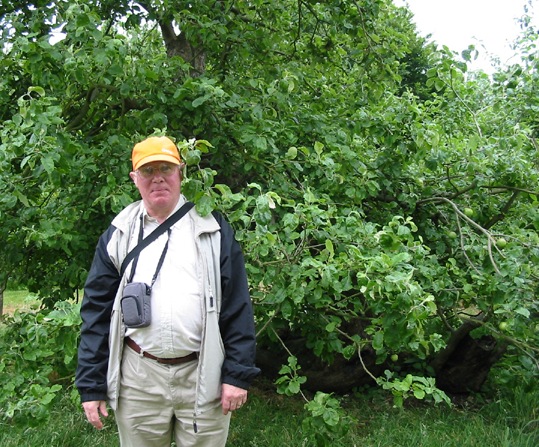 Newton's ideas on gravity, optics and calculus date from this period at Woolsthorpe. Now belonging to the National Trust, you can see his bedroom where he did his experiments on optics and from the window in front could see the apple trees, and here is Mervyn Hobden standing in front of the remains of the actual tree which gave Newton his ideas as he watched apples drop from it, from his bedroom window.
Newton's ideas on gravity, optics and calculus date from this period at Woolsthorpe. Now belonging to the National Trust, you can see his bedroom where he did his experiments on optics and from the window in front could see the apple trees, and here is Mervyn Hobden standing in front of the remains of the actual tree which gave Newton his ideas as he watched apples drop from it, from his bedroom window.
Newton's three laws of gravitation were used to calculate the orbits of the moon and planets, and have been used in calculating the path of space probes. But the bodies in the solar system have more that one force acting upon them. This set a challenge for astronomers trying to calculate the moon's orbit in the 18th century.
1669 - Newton succeeded Barrow as Lucasian Professor of Mathematics, so he now had funds for his research and for printing papers. Much of this work was on alchemy. Which must have been useful to him later when he was put in charge of the Royal Mint.
He became an intense academic rival to Hooke. He hated Hooke and waged a vendetta against him.
Newton was a compulsive notetaker and would take notes from every book he read. He wrote notes over everything - old bills, receipts, any bits of paper. His study was chaotic. His dog Diamond knocked over a lamp and set fire to some of his papers. He said "Diamond! you don't know what you have done!" He didn't know himself what papers he had lost. His secretary said that he studied all the time, never going out for a walk or any leisure activities. He often went about with his stockings hanging down and his hair uncombed. sometimes he forgot where he was going and forgot to eat his meals.
When he was older, his niece Kitty Barton "the toast of the Kitkat Club" looked after him, and through her contacts Newton was made Master of the Mint. He also became a Member of Parliament and was on committees.
In 1673, the Dutch physicist Christiaan Huygens published a landmark treatise on the measurement of time.
In this he described the first clock using a pendulum to control the stability of oscillation, which he had invented in 1656.
He went on to describe a pendulum clock mounted in gimbals to find the Longitude at sea. Furthermore, Huygens' design was backed up using mathematics, synthetic geometry to qualify his reasoning.
Holland, as a major seafaring nation, had great need of a solution for the longitude problem. This invention had a dramatic effect on the practical technology of the time, by 1657, Fromanteel was selling pendulum clocks in London.
The sea clock was a failure, it performed well in a flat calm, but was useless in any seaway. It also varied too much with temperature, some form of compensation was required.
Numerous attempts were made by other inventors, such as Robert Hooke, to overcome these problems, mainly by the substitution of a balance spring controlled balance.
The RGO was founded in 1675 by decree of Charles II. He had been pressured to do so, since there already an observatory in Paris, by a number of people including his French mistress (and spy for Louis XIV) Louise de Keroualle.
Louise had proposed a friend of hers, Pierre St.Pierre to run the Observatory - as he had a brilliant scheme for finding longitude. A young (born 1646) astronomer from Derbyshire, John Flamsteed was given the task of interviewing Pierre St. Pierre, and quickly discovered that what he proposed dated from an old publication of Gemma Frisius in 1530, and that Pierre had no practical suggestion as to how the requisite tables could be generated. So Flamsteed got the job!
And became the first Astronomer Royal. John Flamsteed, was charged "to apply himself with the most exact care and diligence to the rectifying of the tables of the motions of the heavens, and the places of the fixed stars, so as to find out the so much desired longitude of places for the perfecting the art of navigation."
The site chosen was on the remains of a 15th century tower part of the original castle at Greenwich, on a hill in the grounds of Greenwich Palace, no longer occupied by the King.
Sir Christopher Wren who was not only a famous architect but Savilian Professor of Astronomy at Oxford University, was called in to design the building.
The plan incorporated a magnificent Octagon Room above the astronomer's ground floor flat, with three Tompion clocks built in. This was supposed to be the main observatory. A picture shows astronomers with telescopes at the windows in broad daylight. And a transit quadrant perched by a little balcony. In fact this room was useless for observing transits, as, unlike the Paris Observatory, the building had not been correctly aligned. To save costs, the new observatory was built over the crumbling foundations of the old tower. In observatories the transit instrument, which is needed to compile the tables, the main purpose of the observatory, is not only precisely aligned north-south it is firmly fixed in solid ground to avoid any movement. The foundations of the Paris observatory went down to the bed rock.
Flamsteed had to build a wall in a garden shed with the correct alignment, on which he could fix a 7-foot quadrant with telescopic sights to measure and record the position of the stars as they passed the north-south meridian. Flamsteed invested £120 of his inheritance after his father died, on a new 10-foot quadrant designed by Robert Hooke, but complained that it trapped his fingers.
Flamsteed had to buy most of the equipment and furniture he needed. His stingy and rarely paid salary meant he had to take on paying students to make ends meet, one of these was Edmund Halley, who was to become his successor as Astronomer Royal. Flamsteed's wife Margaret who he married when he was aged 46, was one of the assistant astronomers.
Flamsteed was reluctant to publish his star tables before he felt the work was complete. But in 1704, Queen Anne's husband, Prince George of Denmark, who as Lord Admiral was interested in astronomy and the problem of longitude, and advised by Newton, undertook the cost of publication.
Despite the prince's death in 1708 and Flamsteed's objections, 400 copies were printed in 1712, prepared for the press by Edmond Halley. Flamsteed was furious at the pirating of his work, calling Halley "a malicious thief" and taking legal action. He won his case and was able to get 300 of the 400 copies already printed destroyed.
After Flamsteed's death in 1719, his wife Margaret took all the instruments, furnishing and papers, (which were hers anyway) and with Flamsteed's assistant astronomer, Abraham Sharp, finished and published his tables in 1725.
Called the Historia Coelestis Britannica, it listed more stars - 3,000 - than previous tables - and gave their positions much more accurately.
Flamsteed's successor Edmund Halley, found he had inherited an empty building. Halley insisted that the observatory should be equipped by a Royal grant. Halley included among his many scientific interests the problems of navigation.
Edmund Halley, was perhaps the first astronomer to realise the importance of the history of the science. Looking back through ancient records of eclipses, Halley discovered that the Moon was apparently accelerating over the years. We now know that in fact the friction of the tides is slowing the Earth's rotation down.
The Astronomer Royal was provided with a job and a house with it, for life. Halley's attempt to resign because of his advanced age, in favour of James Bradley was turned down. Bradley became the Astronomer Royal when Halley died in 1742.
1656 October 29, born in London, six weeks after his parents got married. His father was rich then, he owned a soap factory. Edmund went to St.Paul's School, became school captain. At 17 went to Oxford University with an allowance from his father of £300 a year(equivalent to more than £60,000 today).
Halley wrote to Flamsteed, the first Astronomer Royal asking to work for him at the RGO during vacations. Flamsteed liked free help, but didn't like Halley much, thought he was a rich playboy.
When Halley 20, his father financed an expedition to St.Helena so that he could make his name by compiling a catalogue of southern stars. Halley complained that it rained a lot, but he spent the rainy nights with the governor's wife.
Two years later Halley returned with his catalogue. By naming a constellation "Charles' Oak" after the tree Charles II hid in, he ingratiated himself with that monarch and was awarded an honorary MA at Oxford and Fellowship of the Royal Society.
l672 Halley's mother died. Halley was sent by the Royal society to Gdansk, then Danzig, to visit Hevelius, who was getting old and refused to use a telescope as sights for his instruments. His observations therefore were not as accurate as they could be. Halley was supposed to persuade Hevelius to adopt newer technology.
After his first wife died, Hevelius at 52 had married a girl of 16, Elizabeta, who he trained as his assistant. Elizabeta and Halley stayed up in the observatory long after Hevelius had gone to bed. When Hevelius got suspicious, Halley returned to England.
Soon after Hevelius's observatory was burned to the ground in a great fire. At first it was thought in England that Hevelius had did in the flames. Halley sent Elizabeta a silk dress in the latest fashion which cost £6-8s.-4d. - equivalent to at least £1350 now) which he said she could wear when she was out of mourning. But Hevelius had survived and was rebuilding his observatory.
1680 bright comet - Halley went to Paris to see Cassini now at the Paris observatory who thought his was the comet Tycho Brahe saw in 1577.
1682 the year of Halley's Comet. This was also the year Halley married Mary Tooke. They lived in a house in Islington and had two daughters and one son.
Halley worked on the Earth's magnetic field, atmospheric pressures, atoms, and minerals.
In 1684, Halley's father was murdered. He left everything to his new second wife. Halley contested this will, because of the suspicious circumstances, which now left him struggling for an income to support himself and his wife and family.
By using observations made of the comets of 1680 and 1682, Halley calculated that comets have elliptical orbits.
Halley noticed that the orbit of the 1682 comet coincided with observations made by Kepler of the 1607 comet and by Apian of the 1531 comet and that they were - to go by the orbit- the same comet. He predicated its return in 1758.
Newton heard of Halley's work and met Halley. At the Royal Society both Halley and Robert Hooke claimed to have already worked out the laws of planetary motion. Christopher Wren offered a prize (a book) to whoever first could offer the proof, Halley went to Cambridge to discuss his work with Newton. He persuaded Newton to write up his work in the "Principia" - "The Mathematical Principles of National Philosophy".
The Royal Society would not finance the Principia because they had published Francis Willoughby's "The History of Fishes". This was very expensive to produce as it was full of colour plates and had been a financial disaster. Halley financed the Principia himself and wrote an ode to Newton which is printed in front.
Halley himself did not have much money at this time to keep his family. In his job as Clerk to the Royal Society he was supposed to get £500 a year but instead was paid in remaindered copies of "A History of Fishes". He edited Philosophical Transactions... the journal of the Royal Society.
Also in 1687 Halley proposed in a paper that the age of the Earth could be determined by the rate of increasing salinity of the seas and lakes as the fresh water evaporated. This scientific approach to estimating the age of the Earth annoyed the Establishment.
In 1691 Halley was trying out a diving bell he invented for a salvage operation off the coast of Sussex when the Comptroller to the Archbishop of Canterbury turned up. The archbishop wanted the election to the Savillian Chair in Astronomy at Oxford University for which Halley had been proposed, to be postponed until Halley returned to London and cleared himself of the charge of asserting the existence of the world from all eternity.
Halley was to publish in 1716, "The art of Living Underwater".
In 1694, Halley in a paper for the Royal Society said that Noah's Flood in the Bible may have been caused by the Earth's close encounter with a comet. This idea was taken up by William Whiston in "A New Theory of the Earth" 1696, - in which past catastrophes like the flood were said to have been caused by the impact of comets on the Earth. (An idea revived in the 1980s). As a result of this book, Whiston was refused Fellowship of the Royal Society and was sacked as Lucasian Professor of Mathematics at Cambridge.
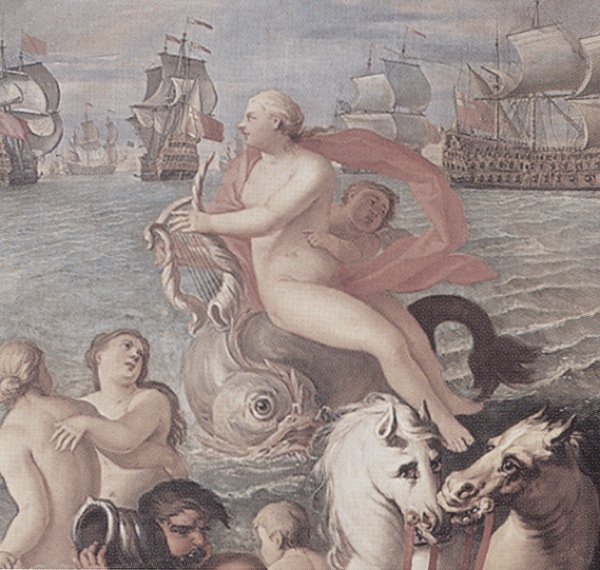 Flamsteed had been reluctant to publish his work on the astronomical tables, until complete, but the Navy was waiting for the new tables essential for finding longitude. In 1704 Prince George of Denmark, (that is his portrait on a fresco at Hampton Court) husband of Queen Anne, and who as Lord Admiral was interested in astronomy and the problem of longitude, undertook the cost of publication. Despite the prince's death in 1708 and Flamsteed's objections, 400 copies were printed in 1712, prepared for the press by Edmond Halley.
Flamsteed had been reluctant to publish his work on the astronomical tables, until complete, but the Navy was waiting for the new tables essential for finding longitude. In 1704 Prince George of Denmark, (that is his portrait on a fresco at Hampton Court) husband of Queen Anne, and who as Lord Admiral was interested in astronomy and the problem of longitude, undertook the cost of publication. Despite the prince's death in 1708 and Flamsteed's objections, 400 copies were printed in 1712, prepared for the press by Edmond Halley.
Flamsteed was furious at the pirating of his work,calling Halley "a malicious thief" and taking legal action. He won his case and was able to get 300 of the 400 copies already printed destroyed. His wife Margaret continued working on the tables after her husband's death in 1719, as mentioned earlier, and published them in 1725.
She had kept the instruments which had been paid for by her husband, which meant that when Halley took over as Astronomer Royal, he needed to resupply the observatory. He was able to get government funding for this.
Has orbited the Sun about 2300 times and is about half way through its life span.
Here is a list of its recorded visits:
For the first time the comet's nucleus itself was seen. A black (mostly carbon and ice, typical of a Kuiper-belt body) odd shaped body, like two stuck together, with mountains and craters. As it rotated, the side facing the Sun erupted as the icy mantle steamed off and was blown away from the Sun by the solar wind. As Giotto got near the body of the comet, the streams of small stony particles in the gases steaming off hammered Giotto and put the camera out of action. Many of the other instruments survived and the probe was put to further use two years later.
To avoid the problems arising by the use of glass lenses in refractors, mirrors could be used - to make a reflector telescope. Light from the stars passes down the telescope to the concave surface of a mirror at the far end. From this, the primary mirror, the light is reflected back to a focal point down the telescope. If the telescope was big enough, the astronomer could perch here. As in the 200 inch Hale telescope finished after World War 2, where the astronomer perched in a cage to look after the camera and was stuck there all night with radio, chocolate bars, thermos of tea, and by the end of his shift, a straining bladder.
In a smaller telescopes, the focussed image must be directed to an eyepiece outside. There are different ways of doing this. Caroline and William Herschel, who built the largest reflecting telescopes in the 18th century, designed a slightly tilted mirror so the focal point met the eyepiece at the end of the telescope where the observer perched on a platform. This was still only practical for large telescopes as the astronomer would obscure too much of the light passing down the telescope to the mirror.
The first reflecting telescope was invented by James Gregory (1638-1675) who published his idea in his "Optima Promota" in 1663, while till living in Aberdeen. Soon after he went to Padua University. In 1669, he was made Professor of Mathematics at the University of St. Andrews. In 1674 he was a professor at Edinburgh University. A year later he was suddenly struck with blindness while showing his students how to observe Jupiter through a telescope. In the Gregorian reflector the image is reflected back from a concave mirror through a gap in the primary mirror to the eyepiece.
In 1671, Newton showed his design for a reflecting telescope to the Royal Society. In Newton's reflector, light is collected by a concave mirror at the end of the tube, and bounced back to a flat mirror which is at an angle of 45 degrees. This directs the light to focus at the eyepiece at the side of the tube.
In 1672, Cassegrain submitted two scientific papers to the Academy of Sciences in Paris. One was on the megaphone, the other was his own design for a reflecting telescope. This is similar to Gregory's but with a convex secondary mirror. Not only can this design be more compact, it has much less spherical aberration (the distortion and blurring caused by two mirrors or lenses). From it developed telescopes like the 1970s Isaac Newton.
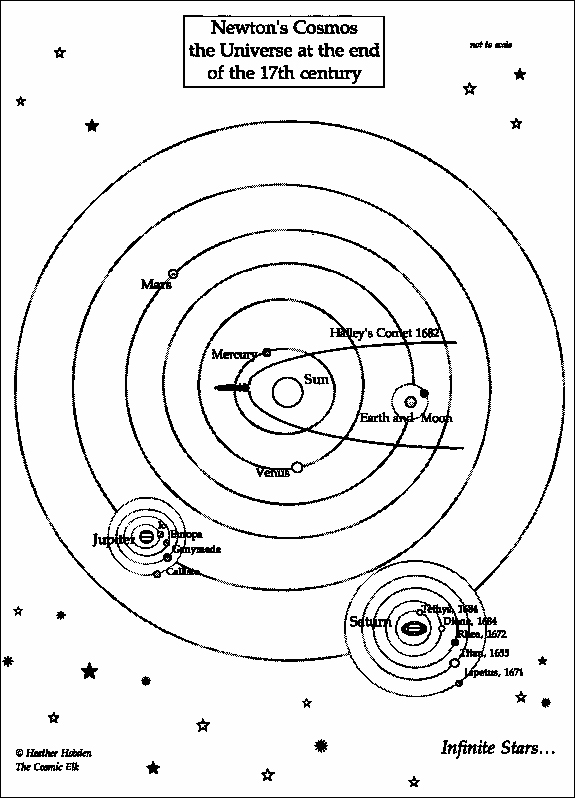
(diagram by Heather Hobden drawn for an exhibition at Woolsthorpe in early 1990s)
Newton described the Universe in the Principia and in some of his notes. From this we know that the stars were thought to be at great distances, about 30,000 times greater than that of the earth from the Sun, Newton writes. He calls the stars "fixt stars", because he thought that they always remained in one place and did not move in space. They were scattered through space and the number of stars seemed to be endless.
Newton said that the Sun "seems to be a body of the same kind with the fixed stars, but appears much bigger by reason of our nearness to him. And the fixed starrs seem to be Sunns in the several regions placed at great distances from one another for illuminating all places, & to be equal in magnitude to our Sun, more or less." (This idea dates from the 16th century but even in Newton's time, remained controversial).
Newton described the Sun as a round body in the form of a globe, and said that it turns round about an axis in the space of about 26 or 27 days. He described the sun spots that revealed the sun's rotation.
Newton accepted and had proved the planets moved in elliptical orbits round the sun. He thought the Moon to be about 50 times smaller than the earth, and almost a million times smaller than the sun. He knew the moon rotated once a month so the same side was always turned towards us. "...through good Telescopes her body appears full of mountains with shadows falling from them opposite to ye Sun."
Newton described the phases of Mercury and Venus, and said of Venus that it "hath a lucid spot upon her body wch revolves in 23 hours." He also says rather more accurately "Mars hath spots upon his body wch revolved in 24 hours 40 minutes. And Jupiter hath spots upon his body wch revolve in 9 hours 56'." Jupiter "is accompanied with four small Planets or Moons moving about him".
Five of Saturn's satellites were discovered in Newton's lifetime. Titan, was discovered by Huygens in 1655, and four were discovered by Cassini, who also discovered a gap in Saturn's rings (the Cassini division). Iapetus was discovered in 1671, Rhea, in 1672, and Tethys and Dione in 1684.
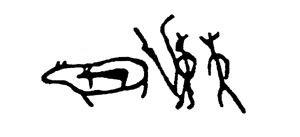 |